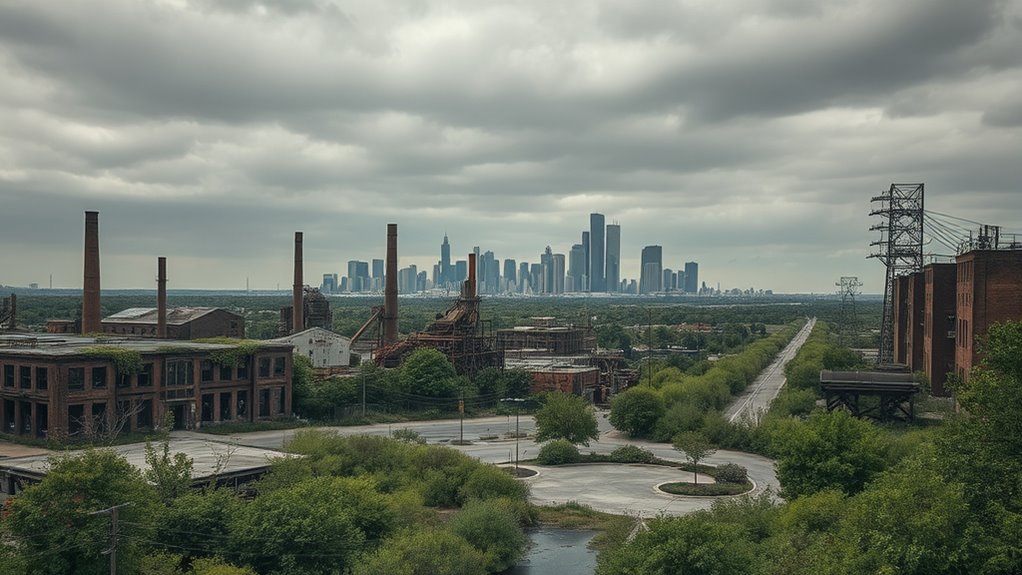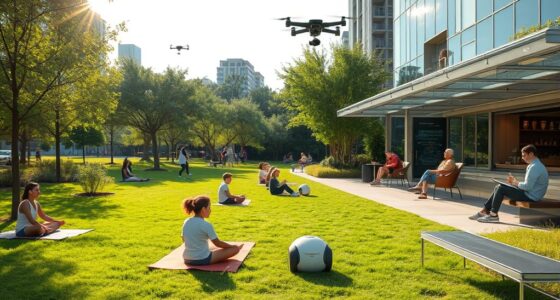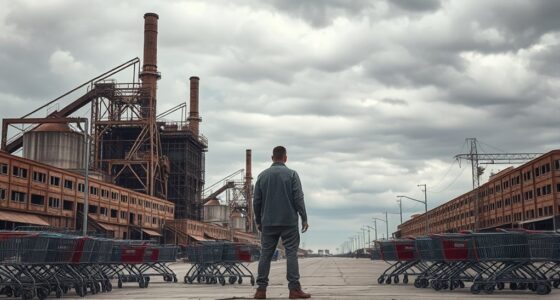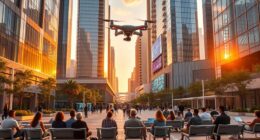In post-labor cities, urban planning shifts from focusing on industrial jobs to creating vibrant, service-oriented communities. You’ll see cities prioritizing social, cultural, and recreational spaces that enhance quality of life rather than just factories and work hubs. Dispersal to suburbs and new towns encourages resilience and diverse economies. Transportation improvements support mobility without relying on industrial centers. If you keep exploring, you’ll discover how these changes reshape urban life beyond traditional job dependence.
Key Takeaways
- Urban planning shifts focus from industrial jobs to enhancing social, cultural, and recreational amenities for improved quality of life.
- Cities are designed as multifunctional hubs that support diverse activities beyond employment, fostering resilient communities.
- Decentralization of populations to suburbs and new towns reduces dependence on single industries, promoting economic and social flexibility.
- Transportation and infrastructure are emphasized to facilitate seamless movement and accessibility, less tied to traditional job centers.
- Urban regions prioritize social cohesion, cultural integration, and community services to sustain vitality without relying solely on employment hubs.
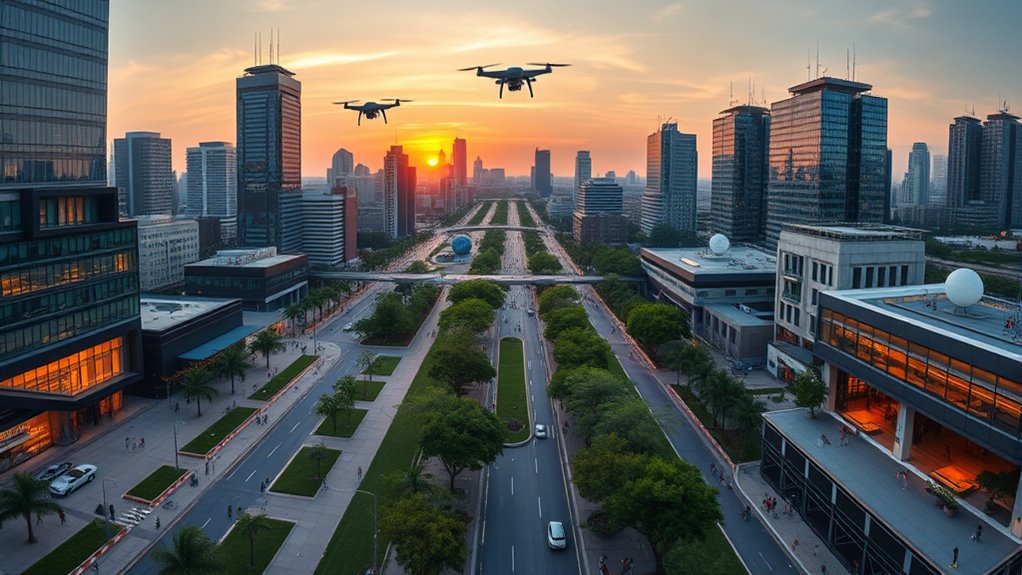
Post-labor cities mark a shift from traditional urban centers rooted in industrial production to diverse, service-oriented communities. Instead of relying on factories and industrial hubs to define their identity, these cities now focus on providing a broad range of social, cultural, and recreational services. You no longer see urban areas as solely economic engines; instead, they become platforms for multiple activities that enhance residents’ quality of life. This transformation stems from historical planning efforts that aimed to decentralize populations and reduce overconcentration in city cores. Post-World War II initiatives, like the UK’s Greater London Plan or Sweden’s Million Programme, moved residents into new towns and suburbs, prioritizing affordable housing and better living conditions. These efforts aimed to ease overcrowding and create balanced urban-rural development. In the U.S., new towns such as Reston and Columbia emphasized residential amenities over industrial activity, reflecting a shift toward livability and community cohesion. European efforts also focused on urban renewal, redistributing populations and clearing slums to foster healthier, more equitable communities. These policies marked a move away from industrial dependence, promoting polycentric regions with multiple centers of activity.
As a city dweller today, you experience this evolution firsthand. Cities are no longer defined solely by their factories or warehouses but by their capacity to serve diverse needs. Urban planning now emphasizes cities as holistic service providers, integrating cultural, educational, and recreational facilities alongside traditional economic functions. Sociologist William Whyte’s view remains relevant: cities are dense, heterogeneous spaces with complex social dynamics. Modern urbanism seeks to reduce reliance on single industrial anchors and instead focus on social equity and infrastructure. This shift often challenges top-down planning approaches, which historically prioritized economic growth at the expense of community needs. Efforts like the Model Cities program highlighted tensions between crime reduction and residents’ demands for better housing and education. Decentralization trends, such as dispersing populations to suburbs and new towns, aimed to improve living standards and balance urban growth. These initiatives also reduced dependency on single industries, fostering resilient, polycentric regions. Furthermore, advancements in transportation technology have made mobility efficiency a central goal for creating sustainable urban environments.
Economically, the focus has shifted from job creation to improving overall quality of life. Sweden’s Million Programme prioritized affordable housing over industrial employment, recognizing that housing and social infrastructure are central to urban vitality. Similarly, U.S. new towns integrated mixed-use areas designed for living and recreation, not solely work. Transportation policies now emphasize mobility efficiency, enabling seamless movement of people and goods without relying on centralized industrial zones. Cities are becoming more adaptable, flexible spaces where economic activity is dispersed, and social and cultural pursuits take center stage. In this new era, urban planning recognizes that vibrant, sustainable cities no longer depend on traditional industrial jobs but thrive through diverse, resilient communities rooted in accessibility, social cohesion, and quality of life.
Frequently Asked Questions
How Will Post-Labor Cities Attract New Residents?
You can attract new residents by offering enticing incentives like cash relocation bonuses, tax breaks, and affordable housing options. Improve livability with vibrant downtown areas, public art, parks, and family-friendly environments. Focus your marketing on niche demographics through social media and cultural branding. Guarantee reliable internet and healthcare accessibility. By creating a welcoming, dynamic community with quality amenities and tailored outreach, you’ll draw people seeking a high-quality, balanced lifestyle.
What Types of New Industries Will Support These Cities?
You’re wondering what new industries will support these cities. As traditional jobs decline, you’ll see growth in sectors like digital services, PropTech, and fintech, which leverage AI, virtual platforms, and smart systems. Sustainable transportation, renewable energy, and health tech will also thrive, focusing on urban resilience and quality of life. These industries will create new opportunities, making cities vibrant hubs of innovation, sustainability, and well-being, even without traditional employment anchors.
How Will Urban Infrastructure Adapt Without Traditional Employment Hubs?
Think of your city as a chameleon, shifting its colors to adapt. Without traditional employment hubs, urban infrastructure transforms into a flexible network. You’ll see smarter roads for bikes and EVs, green corridors replacing highways, and community hubs sprouting where offices once stood. IoT and data guide resource use, making the city more resilient. Connectivity and shared spaces become the new backbone, supporting a vibrant, dispersed urban life beyond the office’s shadow.
What Social Services Are Needed in Post-Labor Urban Areas?
You need social services that support community stability and well-being. Expand mental health access, especially to address trauma from displacement. Invest in health programs targeting chronic illnesses common in underserved neighborhoods. Strengthen food assistance to combat food deserts, and provide robust support for youth through education, mentorship, and digital literacy programs. These services help residents thrive despite economic shifts, fostering resilience and inclusive growth in urban areas.
How Will Community Identity Evolve in Post-Labor Cities?
Imagine a city where factories close, and residents cling to shared cultural spaces like local markets or community centers. You’ll likely see community identity shifting from job-based ties to shared traditions, local history, and cultural landmarks. As economic anchors fade, neighborhoods will foster deeper bonds around collective memories and unique cultural practices, creating resilient identities rooted in community pride and shared experiences that adapt over time, maintaining cohesion amid change.
Conclusion
So, you see, in these post-labor cities, work no longer holds the title of life’s main event. Now, you’re free to chase endless leisure, cultural flair, or just binge your favorite shows guilt-free. Who needs jobs when urban planning’s got your back with parks, cafes, and art everywhere? Welcome to the future—where your commute is optional, and your purpose is whatever you make of it. Truly, the city that never works… or does it?
